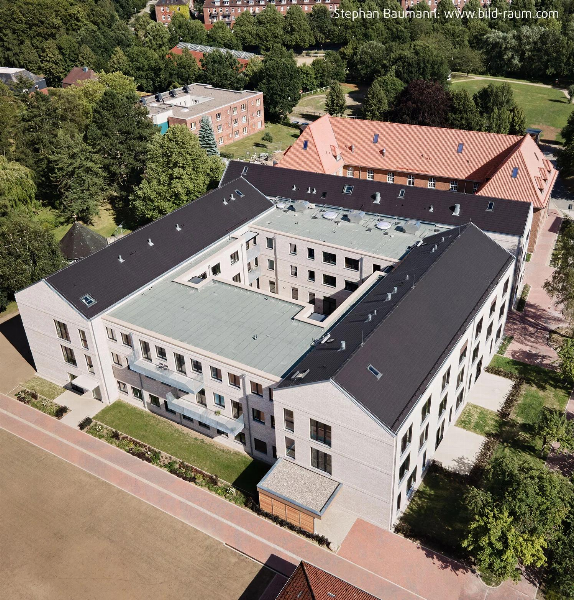Fachklinik für Junges Leben - Kinder- und Jugendpsychiatrie

Triftstraße 139-143
23554 Lübeck
Phone:
0451-400250400
Fax:
0451-404806
Mail:
ed.tsodrondron-einokaid@pjk
- Number of beds: 51
- Number of specialist departments: 2
- Number of inpatient cases: 506
- Number of partial inpatient cases: 59
- Number of outpatient cases: 2.198
- Hospital owners: Diakonie Nord.Nord.Ost in Holstein gemeinnützige GmbH
- Type of provider: freigemeinnützig
Further information
- External quality assurance according to state law
No participation
- Quality of participation in the Disease Management Programme (DMP)
No participation
- Implementation of the minimum quantity agreement
No participation
- Implementation of resolutions of the Federal Joint Committee on quality assurance (G-BA)
No participation
- Clarifying chat completed: no
- Clarifying chat not completed: no
- No participation in clarifying chat: no
- Notification of non-fulfilment of nursing care not made: no
| Number | Group |
|---|---|
| 14 | Medical specialists (m/f) , psychological psychotherapists (m/f) and child and adolescent psychotherapists (m/f) who are subject to the obligation to undergo further training* |
| 10 | Number of medical specialists (m/f) from no. 1 who have completed a five-year period of further training and are therefore subject to the obligation to provide evidence |
| 10 | Number of those persons from no. 2 who have provided proof of further training according to Article 3 of the G-BA regulations |
According to Section 4 (2) of the Quality Management Guideline, facilities must provide for the prevention of and intervention in cases of violence and abuse as part of their internal quality management. The aim is to prevent, recognise and respond appropriately to abuse and violence, particularly against vulnerable patient groups such as children and adolescents or people in need of help, and also to prevent it within the facility. The respective procedure is aligned with the size of the facility, the range of services and the patients in order to define customised solutions for sensitising the teams as well as other suitable preventative and interventional measures. These may include information materials, contact addresses, training/education, codes of conduct, recommendations for action/intervention plans or comprehensive protection concepts.
- Is a protection concept in place? Yes
- No care for children and young people
- Drug commission
Training of employees on AMTS related topics
Availability of appropriate, topic-specific informational materials for patients on AMTS e.g. for chronic diseases, for high-risk drugs, for children
- Fallbesprechungen
- Spezielle AMTS-Visiten (z. B. pharmazeutische Visiten, antibiotic stewardship, Ernährung)
- Teilnahme an einem einrichtungsübergreifenden Fehlermeldesystem (siehe Kapitel 12.2.3.2)
- Admission to hospital, including anamnesis
; Instruments and measures are presented for determining the old medication (drug history), the subsequent clinical assessment and the switch to the medication available in the hospital (house list), as well as for documenting both the patient's original medication and that for hospital treatment adapted medication.
- Medication process in the hospital
In this context, the following sub-processes are assumed as examples: drug history - prescription - patient information - drug delivery - drug use - documentation - therapy monitoring - result assessment. Instruments and measures for safe medication prescription can be presented, e.g. B. in terms of readability, clarity and completeness of the documentation, but also in terms of area of application, effectiveness, benefit-risk ratio, tolerability (including potential contraindications, interactions, etc.) and resource considerations. Information can also be provided to support reliable medication ordering, delivery and use or administration.
- Discharge
In particular, the measures taken by hospitals can be presented to ensure that information on drug therapy is structured and passed on to doctors and physicians providing further treatment, as well as the appropriate provision of patients with drug information, medication plans and medications. Drug prescriptions are made.
Job
FL05 - Participation in multi-centre Phase I/II studies
Explanation
FL04 - Project-related cooperation with colleges and universities
Explanation
FL03 - Student training (clinical traineeship / internship year)
Explanation
Training in other healing professions
HB02 - Health and paediatric nurse (m/f)
Comment
- Hospital staff
- Number of pharmacists: 1
- Additional staff: 1
Oliver Soyka
Chefarzt
Triftstraße 139-143
23554 Lübeck
Phone:
0451
-400250434-
Mail:
ed.tsodrondron-einokaid@akyos.revilo
Dipl.-Psychologe Stefan Scholten
QMB / Ltd. Psychologe
Triftstraße 139-143
23554 Lübeck
Phone:
0451
-400250434-
Mail:
ed.tsodrondron-einokaid@netlohcs.nafets
Oliver Soyka
Chefarzt, Vorsitzender der Hygienekommission
Triftstraße 139-143
23554 Lübeck
Phone:
0451
-400250434-
Mail:
ed.tsodrondron-einokaid@akyos.revilo
Julia Thiel
Leitung Pflege- und Erziehungsdienst
Triftstraße 139-143
23554 Lübeck
Phone:
0451
-400250400-
Mail:
ed.tsodrondron-einokaid@leiht.ailuj
23554 Lübeck
Phone:
0451-400250400
Fax:
0451-404806
Mail:
ed.tsodrondron-einokaid@pjk
Dipl.-Pädagogin Julia Thiel
Leitung Pflege- und Erziehungsdienst
Triftstraße 139-143
23554 Lübeck
Phone:
0451
-400250434-
Mail:
ed.tsodrondron-einokaid@leiht.ailuj
Jürgen Holznagel
Verwaltungsleiter
Triftstraße 139-143
23554 Lübeck
Phone:
0451
-400250700-
Mail:
ed.tsodrondron-einokaid@leganzloh.negreuj
Oliver Soyka
Chefarzt
Triftstraße 139-143
23554 Lübeck
Phone:
0451
-400250434-
Mail:
ed.einokaid-rekrewrov@akyos.revilo
Dr.med. Michael Lipp
Leitender Oberarzt
Triftstraße 139-143
23554 Lübeck
Phone:
0451
-400250434-
Mail:
ed.tsodrondron-einokaid@ppil.leahcim
IK: 260101547
Location number: 772538000
